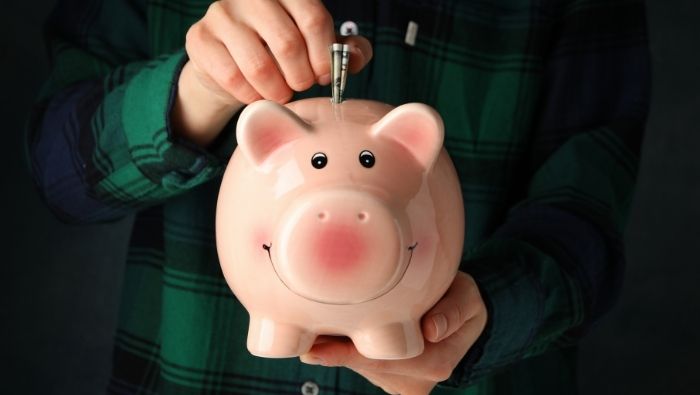Tricks for Stashing Small Savings (So It Doesn’t Disappear)
by Reader Contributors

You know you’ve been cutting back on your spending, but are you actually saving your savings? If those extra dollars you’ve saved always seem to vanish, try these tricks from our savvy readers to ensure those savings actually make it into a savings account.
Dear Dollar Stretcher,
We focus on frugal living and saving dollars, but what happens to the $2.50 I save on groceries or the $50 I save on car repairs?
Do any of your readers have suggestions on directing those savings into savings? I suspect that I often save a few dollars at the grocery store and later spend it on some other frivolous activity or item. I sure could use some help with this.
Linda
Move It To Savings As You Save It
I used to do the same thing — save $15 to $20 at the grocery store on coupons and the like and then wonder in two days where the “saved money” went.
I decided the only way to save the “saved money” was to open a savings account. As soon as I get home and put the groceries away, I go to my computer and move the ‘saved’ amount into my special ‘savings’ account at the bank.
I started doing this one year in January, and by summer, I had enough for a summer camp for the kids and a couple of really nice dinners out for Mom and Dad while the kids were away. After that, I started saving for Christmas presents.
If you saved the money doing all the work of looking for, cutting out and redeeming the coupons, then you deserve to save the savings.
Lynn
Sign Up for Savings
Subscribe to get money-saving content by email that can help you stretch your dollars further.
Twice each week, you'll receive articles and tips that can help you free up and keep more of your hard-earned money, even on the tightest of budgets.
We respect your privacy. Unsubscribe at any time.
Three Workable Ideas for Stashing Small Savings
Here are three ideas you can use to save your “saved” money. I’ve been doing this for four years now and the money really accumulates. The crucial step is to designate your savings for something specific and be consistent in actually putting the money in the envelope or container. (To control our budget, we only use cash, but you could adapt these ideas for those who use credit/debit cards as well.)
- When you shop and use coupons or whatever you do to save, earmark that money for something specific. When I get home from the supermarket, I look at my receipt for the amount that was deducted for the coupons I used. I take that amount and put it in an envelope earmarked for a specific purpose. Some weeks, it’s only $2, but even at $2 a week, you have $104 at the end of a year. I usually round up this money. If I save $1.55 with coupons, I put $2 in the envelope.
- My grocery store has a Bonus card. This money goes into another envelope earmarked for a specific purpose. This can be quite a bit each week. I usually budget $80 a week for food. Let’s say the bill totals $90, and the bonus card saves me $20. $90 spent minus $20 savings = $70 spent, so I put the $10 in the envelope.
- If you pay with cash, save your change! Anytime you purchase something, save the change in a jar or canister, but earmark this money for something specific. This may sound crazy, but I can save $300 a year by doing this.
I found that if you have a specific goal for the money, it’s easier to put the money aside. A goal can be anything from a new coffee pot to dinner out at a fancy restaurant to a vacation. I use my “saved” money to buy birthday and Christmas gifts for my three granddaughters.
Kathy
It’s in The Envelope
We use the envelope system of budgeting. When we save a few dollars, they either remain in the envelope to be added to the next week’s allotment. Or, you can sweep them into another envelope marked “Extra.” When you have enough in the “Extra” envelope, you can either add it to your regular credit card payment or other debt repayment, or you can put it in savings or buy a certificate of deposit, etc.
We also do this with any money left over in the checking account after paying bills. That way, it doesn’t “disappear” on mysterious purchases. Some envelope accounts we let build up, e.g., “home” and “clothes”, because the purchases from them are unpredictable, but others, like “groceries” that have a weekly outlay, get the Extra swept out of them.
Loretta
Goals Make the Difference
Put your savings directly into a jar marked for something special, such as “Night Out” or “Vacation.” You’ll be surprised at how quickly it all adds up.
It’s very important to label the jar or earmark the account; otherwise, you’re liable to take more out than you put in. Having a specific goal keeps you on track.
Betty
Building a Nest Egg in a Can
I still use cash rather than a debit or credit card for most purchases. I take a 46 oz. tomato juice can (I use two cans and make quick tomato vegetable noodle soup), which has the little holes for pouring and rinse it out. Then I take a hammer and a screwdriver and pound out a slot in the center just big enough for money. All of my change, dollar bills, and occasionally bigger bills go into it.
In order to get the money out of the can, you have to open the can with a can opener, which makes you think twice. I just keep starting new cans. I set a goal of what to save for (for instance, a family outing). Once or twice a year, we open the cans, and my daughter and I count out the money with her wrapping up the coins.
Well, it was time and we opened the cans. I had gotten into them in January for one of my goals, so it’s only been about six months. To our amazement, we had about $617 in there. We were able to have our family outing and also buy some small appliances I’ve been wanting.
Carol
Keeping Ahead With a Ghost Fund
When we paid off a car, I kept on moving the money into our ‘ghost’ account. By the time my husband noticed that we “should” have some extra money, I had over a thousand dollars in the bank — it just didn’t show up in our regular account.
We do this with every savings (any money I could have spent but found a way to spend less), and I call it the “Ghost” Fund (because it’s invisible). Coupons at the store? Drop the savings in the ghost fund. Use a coupon code for a discount on an online purchase? Eight dollars into the ghost fund. Bargain down the price of an A/C service call? Put the savings away.
Cecil
Reviewed January 2024
Popular Articles
On After50Finances.com
- 9 Things You Need to Do Before You Retire
- You Didn’t Save Enough for Retirement and You’re 55+
- When Empty Nesters Reorganize and Declutter Their Home
- Reinventing Your Career in Your 50s or 60s
- What Mature Homeowners Should Know about Reverse Mortgages
- 2 Reasons to Collect Social Security Benefits As Soon As Possible



